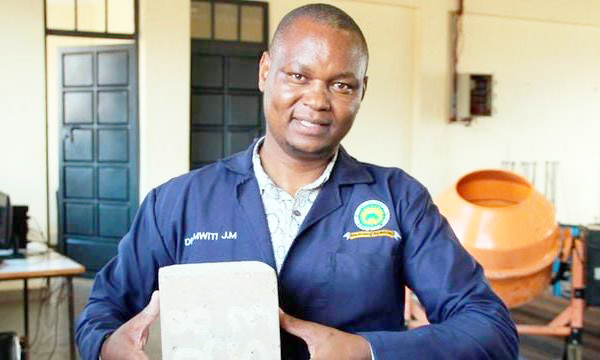Dr Joseph Mwiti’s innovation of manufacturing cement using clay will serve as a welcome relief to thousands of Kenyans who aspire to build home.
Dr Mwiti, a lecturer who teaches Chemistry at Meru University of Science and Technology (MUST), believes that using clay to make cement will revolutionize construction and provide a solution to high costs associated with building roads, bridges and residential and commercial structures.
“Clay will reduce the amount of clinker used in cement-making. Clinker is an important ingredient in the manufacture of cement and its reduction will see the cost of the building input significantly fall,” he says, adding that reducing clinker in cement making will cut down on carbon emission and address concerns of climate change.
He reveals that over the past four years, together with his team of researchers at MUST, he has experimented with clay to make cement and the results have been remarkable.
“Trials have shown that clay-based cement cuts construction cost by more than 40 per cent,” he said, adding that they are exploring ways the technology will be adopted be cement manufacturers to commercialise the invention.
According to Dr Mwiti, some cement makers are considering modifying their machines to adopt the technology while those putting up new plants have committed to incorporate clay cement in the production line.
“We recently invited stakeholders from the cement manufacturing sector to inform them of the progress of our research and they expressed interest in adopting our technology,” he said, further adding that they are in discussions with four major cement manufacturers who are interested in the technology.
The don revealed that they are looking for strategic partners to deploy the technology in counties in a pilot stage as they are keen on demonstrating to community members that they can make money and reduce construction costs.
“By adopting this construction technology, we will save on foreign currency and cushion the economy from the shocks of price volatility in a market dominated by trade in the American dollar,” he said.
Dr Mwiti says cement manufactured using clay will help industrialize the country as many cottage plants will be set up.
“Northern Kenya has a lot of clay. We hope our technology will give us a chance to open up these regions for factories and create jobs and new opportunities. Clay is one of the most underutilised resources in the world. We are standing on a gold mine. This project is unique because it touches on three pillars of the country’s economy – affordable housing, manufacturing and job creation,” he said.
The team’s major challenge is that the Kenya Bureau of Standards (KeBS) does not have a grade for clay-based cement.
“With the knowledge generated from our research, KeBS officials have invited us for talks on how to set the standard for this product,” he revealed.
He further notes that for those who do not like the brown clay colour in cement, the technology incorporates a feature that enables variation of some properties hence one can get the grey colour in conventional cement.
Dr Mwiti said his team has consulted for companies in Cote d’Ivoire, Ghana, Netherlands and several other countries.
Dr Mwiti’s invention has attracted the attention of local and international players in the construction industry and he has been awarded for the same.
Last year, he received the excellence award for post-doctoral research from the Laboratory of Construction Materials, Switzerland.
The Royal Academy of Engineering in the United Kingdom awarded him during the Leaders in Innovation Fellowship.
Locally, the Kenya National Innovation Agency awarded him for the Best Innovation on ‘Eco-friendly Low-Cost Cement’ in the Built Environment and Housing Technologies Category.
He has delivered keynote addresses in many conferences amongst them a construction summit in Ghana and at Cardiff University in the United Kingdom.
By John Majau
Get more stories from our website: Sacco Review. For comments and clarifications, write to :Saccoreview@shrendpublishers.co.ke
Kindly follow us via our social media pages on Facebook: Sacco Review Newspaper for timely update



